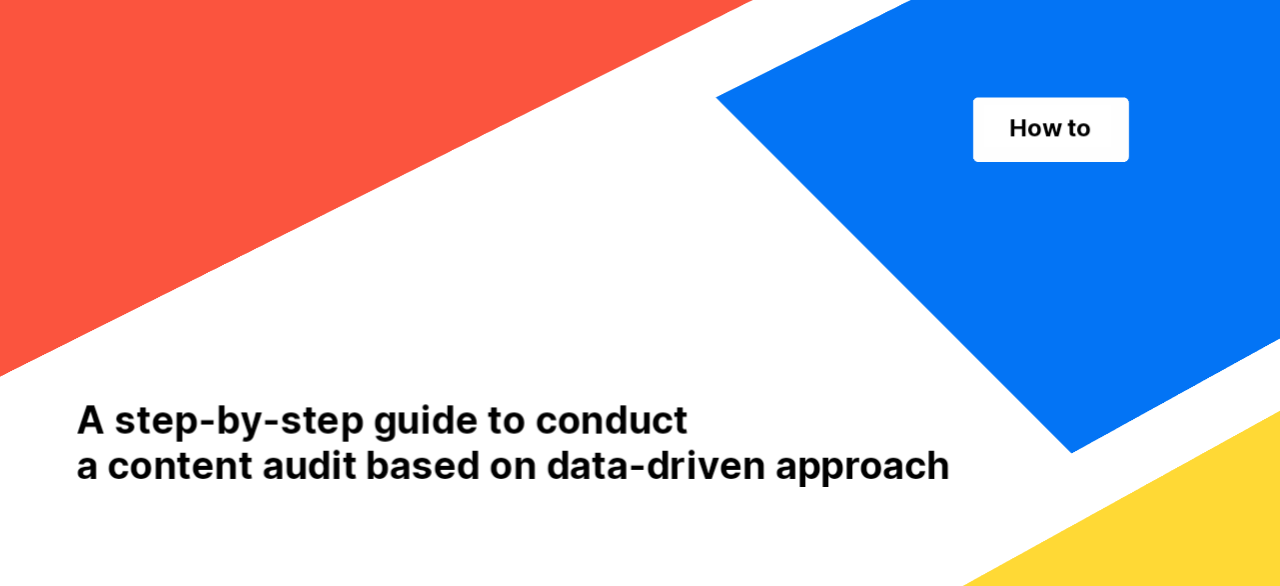
A step-by-step guide to conduct a content audit based on data-driven approach
Performing a content audit might not seem inherently technical within the realm of SEO, but it holds immense potential when utilizing data from technical SEO aspects. In this article, we’ll delve into the process of conducting a content audit using data extracted from JetOctopus, a powerful SEO tool that can unlock a wealth of insights.
What data is needed for a high-quality content audit?
To embark on a content audit journey, you need several key data sources at your disposal. These include a comprehensive website crawl, Google Search Console data, log data, and Google Analytics data. A holistic crawl of your website forms the foundation, allowing you to promptly identify pages grappling with content-related issues.
Evaluating content quality
The initial focus of your content audit should be pages hosting minimal content, often referred to as “thin pages.” Navigating to the “Content” dashboard within crawl results grants access to the dedicated “Thin Pages” data table. Here, you’ll discover a roster of pages featuring less than 100 words.
Furthermore, JetOctopus provides a preconfigured data table spotlighting pages containing less than five hundred words.

Pages lacking substantial content could face indexing and ranking challenges. An inadequate volume of text may hinder search engines’ comprehension of a page’s context and relevance, potentially leading to suboptimal rankings. Similarly, scant content might signify incomplete information, affecting user experience. On the contrary, content-rich pages enjoy improved visibility on Google, as they are better positioned to rank for long-tail keywords.
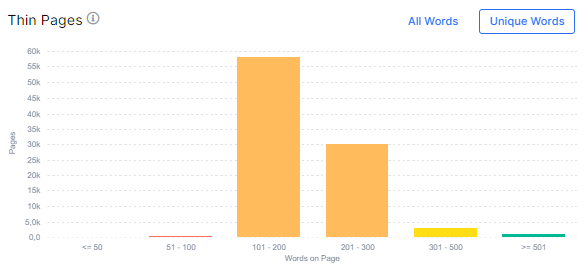
Identifying non-unique content
Within the “Content” dashboard, delve into elements like “Uniq words duplication on page” to uncover instances of indirect content duplication.
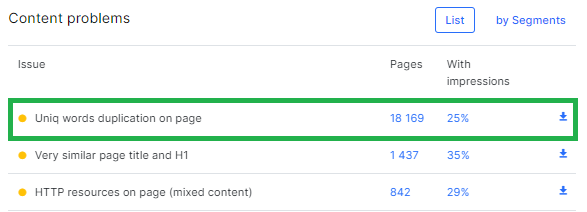
“Uniq words duplication on page” exposes content replication, wherein the arrangement of words holds little relevance to search engines. Pages featuring phrases like “SEO Analyzer and Log Crawler” and “Log Analyzer and SEO Crawler” hold almost the same meaning for Google due to the interchangeable word order. Highlighted as a content problem, addressing such issues is crucial, especially for indexable pages, as duplicate word occurrences might hinder rankings.
Detecting duplicate content
The duplication report plays a pivotal role in the content audit process. Access this report through the crawl results.
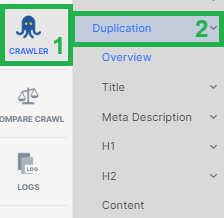
Here you will find all the problems related to your content, for example, duplicate titles, duplicate meta descriptions, pages that do not have H1s or vice versa, have multiple H1s, or that have duplicate H1s.
Analyze each problem in detail and decide what to do with these URLs: either make them non-indexable, or make them unique. It is extremely important to address duplication issues if you want your pages to be attractive to users and rank high in Google.
How to identify the content impact on effectiveness in SERP
Combining Google Search Console data with crawl data unlocks valuable insights concerning content efficacy and growth opportunities. Journey to the Google Search Console section, and navigate to the “Query on Page” data table. Here, distinct data tables like “Query in title,” “Query in meta description,” and “Query in H1” await your exploration.
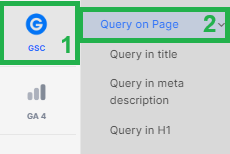
These data tables furnish information about page titles and their alignment with ranking queries. For instance, if a title contains a key query such as “seo crawler,” the corresponding page is highlighted in this data table.

Also, in this list, you can find queries that are not presented at all in the titles of your website. Among these queries, there may be queries that have a very high search volume, so we recommend exporting all queries that are not found in the titles and adding search volume data. If you find among these queries that have a high search frequency, we recommend adding them as a content part.
Analyzing meta descriptions offers another avenue for enhancing click-through rates. Although they don’t directly influence ranking, incorporating popular Google queries in meta descriptions can render snippets more enticing to users. When searchers spot their queries in snippets, their likelihood of clicking through to your website amplifies.
Similarly, scrutinizing “Query in H1” offers insights into user engagement. H1 headers encompassing user-searched queries augment user retention and interaction with your content.
Uncovering content influence on user behavior
Understanding how content shapes user behavior is an indispensable aspect of content audits. To analyze it, in the “Google Analytics 4” section, “Pages” in data tables.
Specify the analysis period and select “Organic/All” as the traffic source.

Integrate the “Crawl pages” dataset and apply a filter for “Body Words Count” greater than zero.
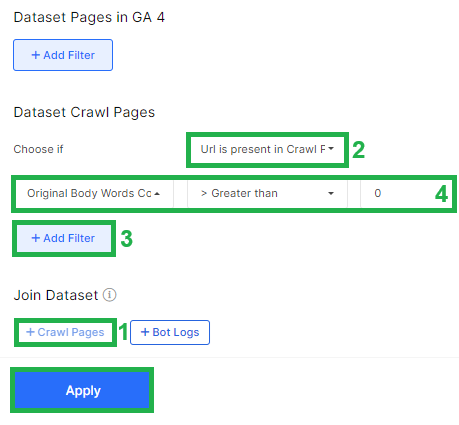
The ensuing list showcases pages receiving organic traffic. Sorting pages by word count facilitates insight into how content length impacts traffic and average session duration. This holistic data aids in grasping content’s influence on user experience. For example, you can filter out the pages with the fewest words and see how much traffic they have and what the average session duration is. This data will help you gain a lot of insights about how content affects the user experience and whether you need to increase the amount of content.
Assessing content impact on search robots behavior
Content quality, authority, and comprehensiveness are pivotal for search engines. Analyzing content’s quantity and quality and how they influence site crawling is vital. Navigating to the “Ideas” section and selecting the “Impact HUB” – “Crawl Budget” data table is the starting point.
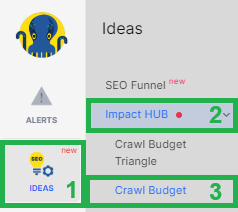
Next, go to the “Bot behaviour by content size” chart.
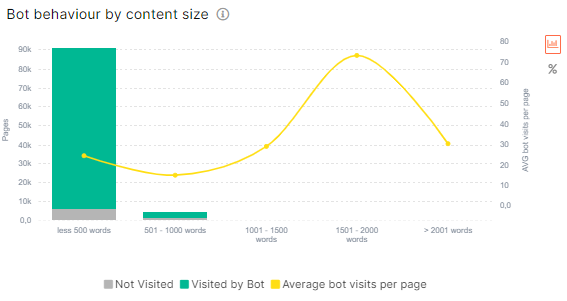
Inspect the crawl rates of pages with ample content, observing how frequently bots revisit these pages. Likewise, assess the crawl patterns of pages with limited content.
Based on the received data, make decisions about further optimization of the content.
Final insights
By harnessing JetOctopus data, you’re empowered to undertake a robust content audit. This process aids in pinpointing pages with inadequate or optimal content volumes. JetOctopus facilitates the identification of fully duplicated and partially duplicated content through non-unique word analysis.
Moreover, Google Search Console data unlocks keyword insights, guiding strategic placement within titles, H1 headers, and meta descriptions. The synergy of Google Analytics and crawl data unveils user behavior intricacies tied to content length.
Lastly, content’s sway on search bot behavior should not be ignored. Assessing the crawling patterns of diverse content-rich and content-sparse pages informs your SEO strategy.
In summation, JetOctopus data enables a comprehensive content audit, offering invaluable insights to elevate your SEO endeavors.

